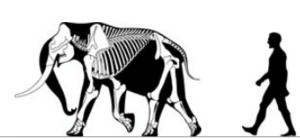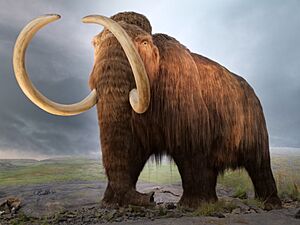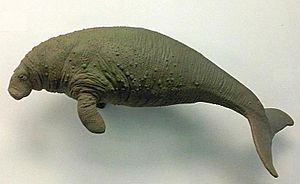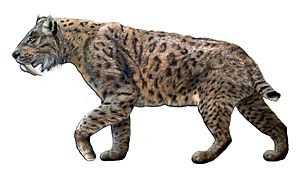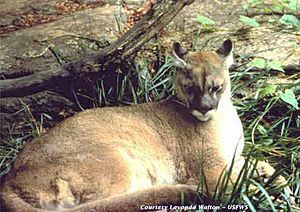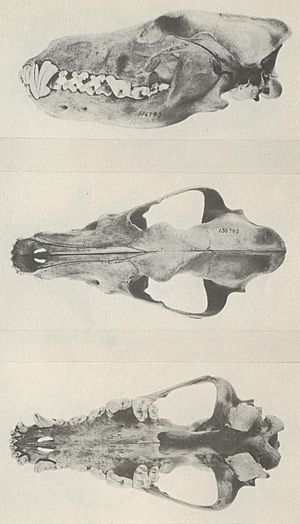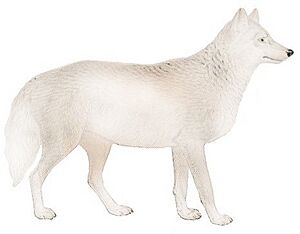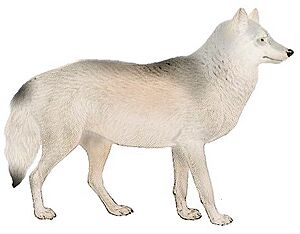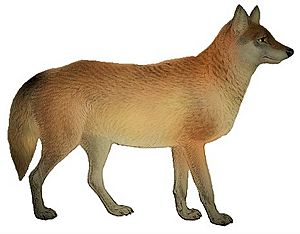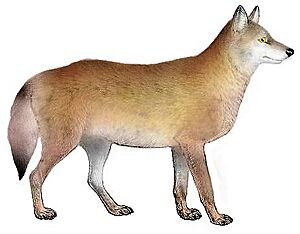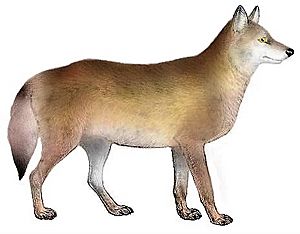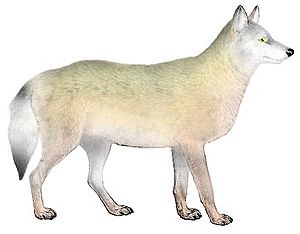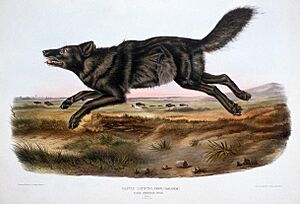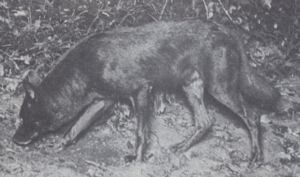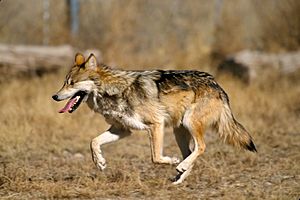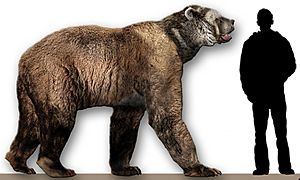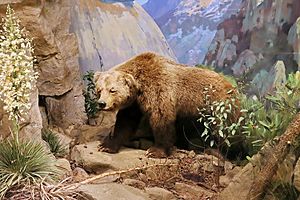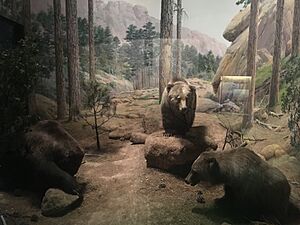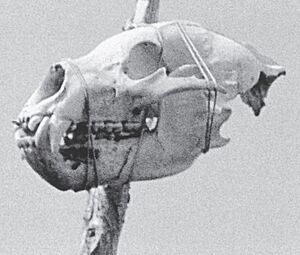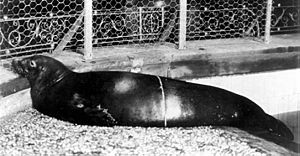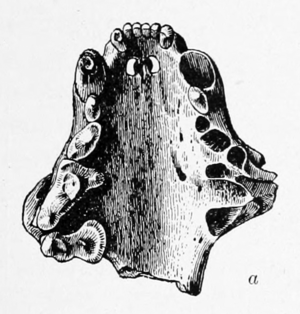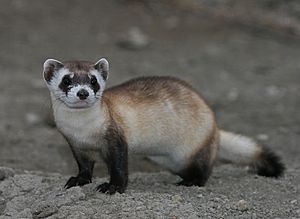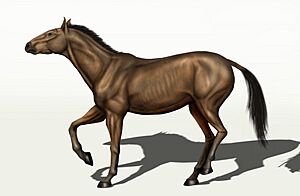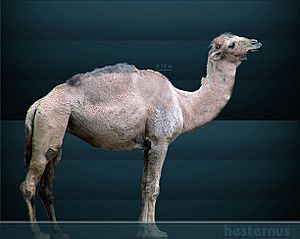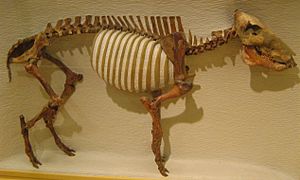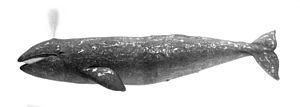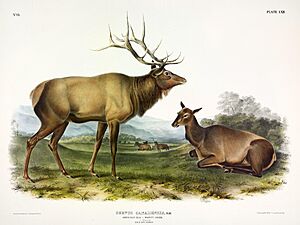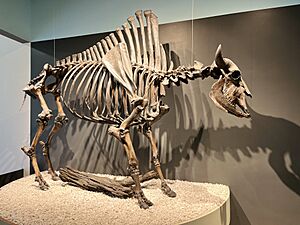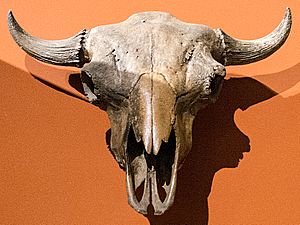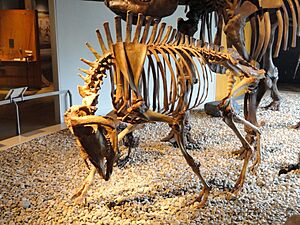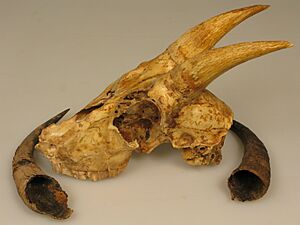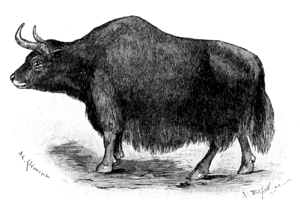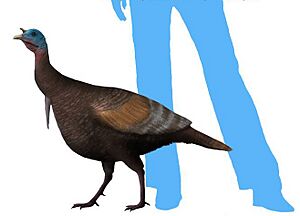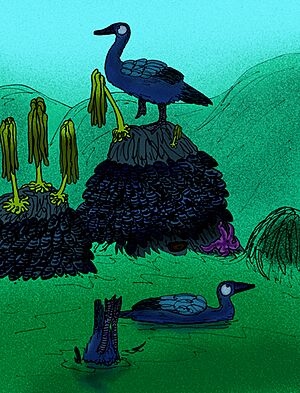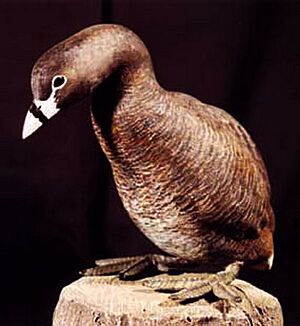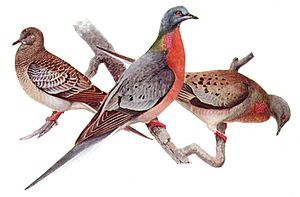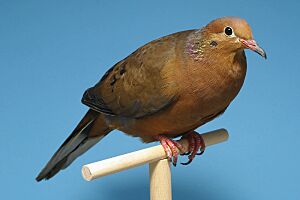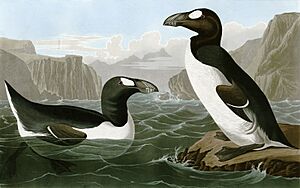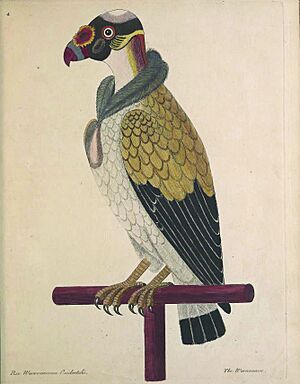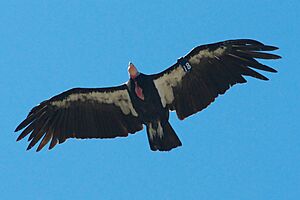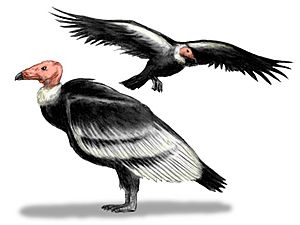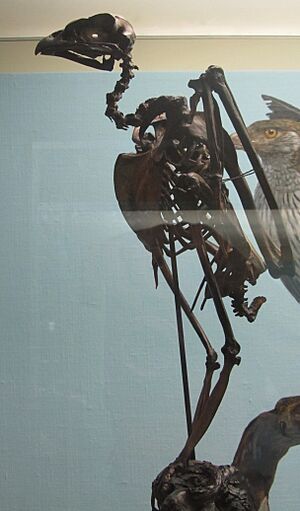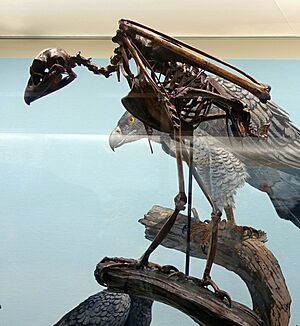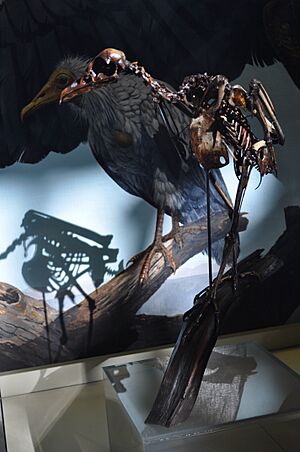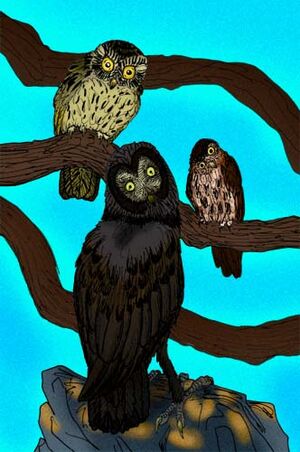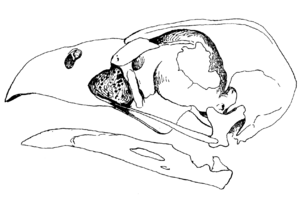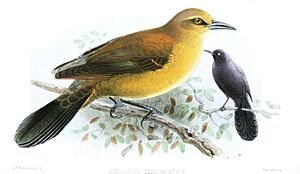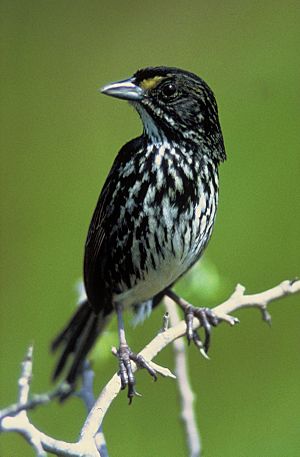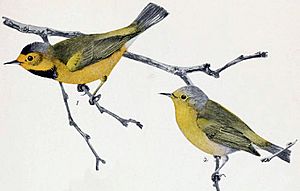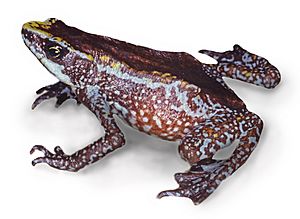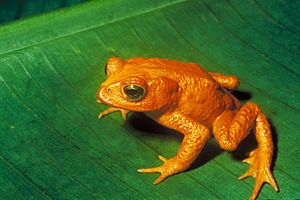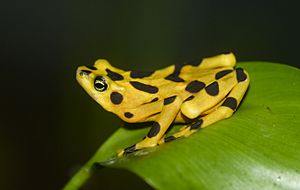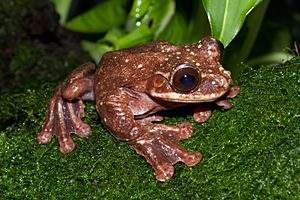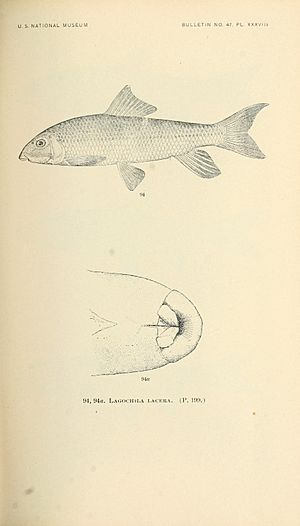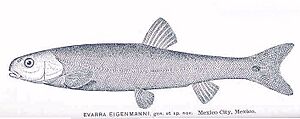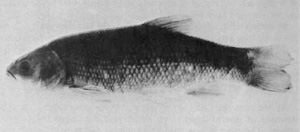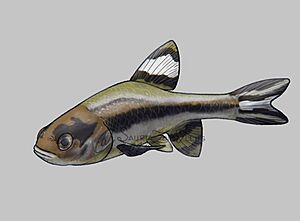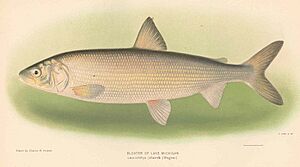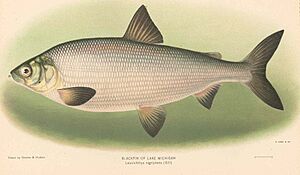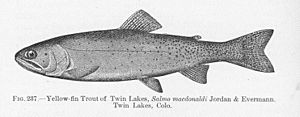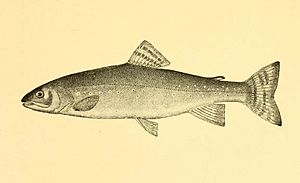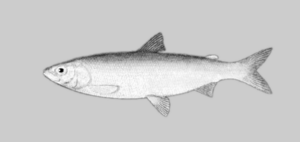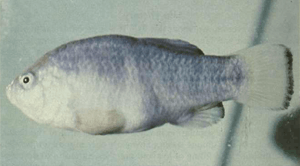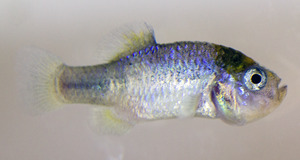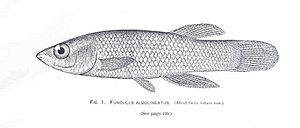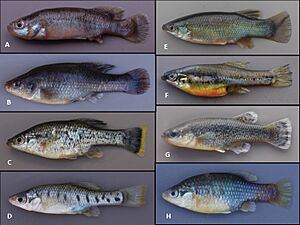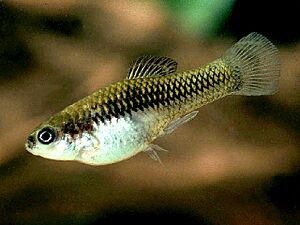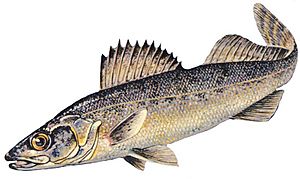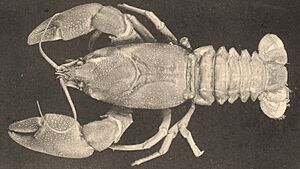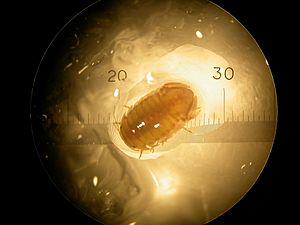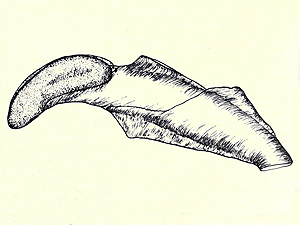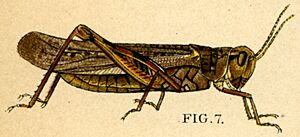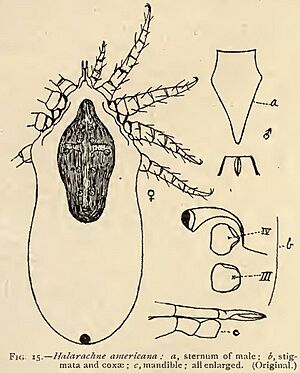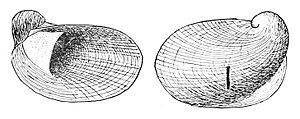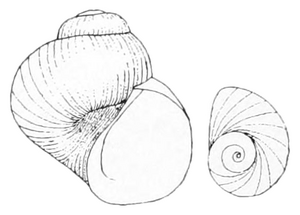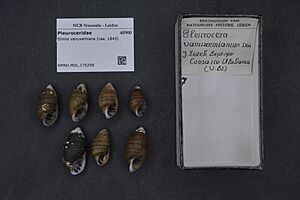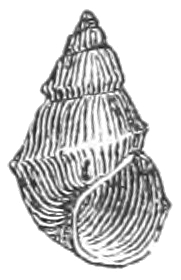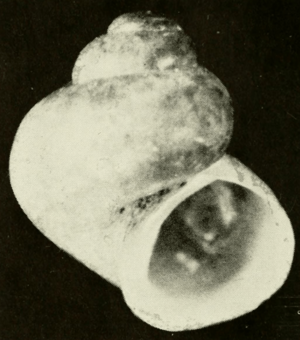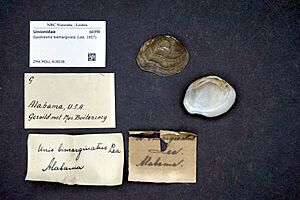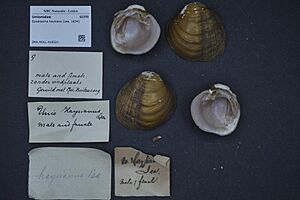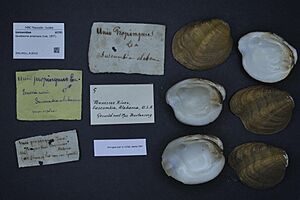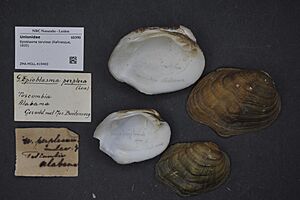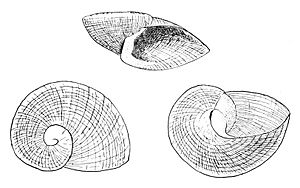List of North American animals extinct in the Holocene facts for kids

This article is about amazing animals that used to live in North America but are now extinct. "Extinct" means they have completely disappeared from Earth. We're focusing on animals that vanished in the last 11,700 years. Animals from the West Indies and Hawaii have their own separate lists.
Sometimes, it's hard to know the exact date an animal became extinct because there isn't enough information.
Contents
- Mammals: Animals with Fur or Hair
- Armadillos, Pampatheres, and Glyptodonts
- Anteaters and Sloths
- Elephant-like Mammals
- Sea Cows
- Lagomorphs: Rabbits, Hares, and Pikas
- Rodents: Gnawing Mammals
- Carnivorans: Meat-eating Mammals
- Odd-toed Ungulates: Hoofed Mammals with Odd Number of Toes
- Even-toed Ungulates: Hoofed Mammals with Even Number of Toes
- Birds: Feathered Friends
- Landfowl: Chickens, Turkeys, and Pheasants
- Waterfowl: Ducks, Geese, and Swans
- Grebes: Diving Birds
- Swifts, Treeswifts, and Hummingbirds
- Pigeons and Doves
- Rails and Cranes
- Shorebirds: Birds of the Coast
- Albatrosses and Petrels
- Storks and Allies
- New World Vultures
- Hawks and Relatives
- Owls
- Falcons
- Woodpeckers and Allies
- Parrots
- Perching Birds
- Reptiles: Scaly Creatures
- Amphibians: Frogs and Salamanders
- Ray-finned Fish: Fish with Bony Fins
- Malacostracans: Crabs, Lobsters, and Shrimp Relatives
- Insects: Six-legged Creatures
- Arachnids: Spiders, Mites, and Scorpions
- Molluscs: Snails, Slugs, and Mussels
- See also
Mammals: Animals with Fur or Hair
Armadillos, Pampatheres, and Glyptodonts
Giant Armadillos and Glyptodonts
Imagine a giant armadillo! The North American glyptodont (Glyptotherium sp.) was a huge, armored mammal. Its last known remains were found near the Gulf of Mexico coast, dating back to around 9,000 to 11,000 years ago.
Anteaters and Sloths
Giant Ground Sloths
North America was once home to several types of giant ground sloths. These were not like the sloths we see today, which live in trees.
- The Jefferson's ground sloth (Megalonyx jeffersoni) lived from Alaska all the way down to northern Mexico. The last ones lived about 11,000 to 11,500 years ago.
- Another type, Xibalbaonyx oviceps, was found in Puerto Morelos, Mexico. It disappeared around 10,000 to 10,500 years ago.
- The Harlan's ground sloth (Paramylodon harlani) roamed Mexico and the Southern and Western United States. Its last known date is about 10,000 to 12,000 years ago.
- The Shasta ground sloth (Nothrotheriops shastensis) lived from California to Yucatan. It vanished around 10,000 to 10,700 years ago.
Elephant-like Mammals
Gomphotheres
Cuvier's gomphothere (Cuvieronius hyodon) was an ancient relative of elephants. It lived in Central America and the northern Andes mountains. The most recent evidence of this animal is from about 10,800 to 11,100 years ago in Guatemala.
Mastodons
The American mastodon (Mammut americanum) was a large, shaggy animal similar to a mammoth. It lived all across North America. The last mastodons died out around 8,800 to 9,100 years ago.
Elephants and Mammoths
- The Columbian mammoth (Mammuthus columbi) lived in the Southern and Western United States, and northern Mexico. It disappeared about 9,700 to 10,000 years ago.
- The Pygmy mammoth (Mammuthus exilis) was a smaller version that lived only on Santa Rosae island, California. It became extinct around 11,000 years ago.
- The Woolly mammoth (Mammuthus primigenius) was famous for its thick fur. It lived in northern Eurasia and North America. The last known woolly mammoths in North America lived on St. Paul, Alaska, about 5,500 to 5,600 years ago.
Sea Cows
Dugongs
Steller's sea cow (Hydrodamalis gigas) was a huge, gentle marine mammal. It lived in the Bering Sea. Sadly, it was hunted to extinction by humans between 1710 and 1785 CE.
Lagomorphs: Rabbits, Hares, and Pikas
Pikas
The Giant pika (Ochotona whartoni) was a larger relative of today's small pikas. It lived in northern North America and possibly northeastern Siberia. Its last remains date back to about 9,100 to 10,300 years ago.
Rodents: Gnawing Mammals
Beavers
The Giant beaver (Castoroides ohioensis) was much larger than modern beavers. It lived across North America. The last giant beavers disappeared around 10,100 to 10,200 years ago.
Hamsters, Voles, Lemmings, Muskrats, and New World Rats and Mice
Many smaller rodents have also become extinct.
- The Gull Island vole (Microtus pennsylvanicus nesophilus) vanished around 1900 from Great Gull Island, New York. This happened when military defenses were built there.
- Anthony's woodrat (Neotoma bryanti anthonyi) from Isla Todos Santos, Mexico, was last seen in 1926. It likely died out because of feral cats.
- Bunker's woodrat (Neotoma bryanti bunkeri) from Coronados Islands, Mexico, was last recorded in 1931. It probably disappeared due to less food and more cats.
- The San Martín Island woodrat (Neotoma bryanti martinensis) from Isla San Martín, Mexico, was last seen in the 1950s. Cats also caused its extinction.
- Nelson's rice rat (Oryzomys nelsoni) from María Madre Island, Mexico, was last recorded in 1897. It might have been outcompeted by introduced black rats.
- The Giant island deer mouse (Peromyscus nesodytes) lived on the Channel Islands of California. Its last remains are from around 950 CE. It may have disappeared due to overgrazing and habitat loss.
- The Pallid beach mouse (Peromyscus polionotus decoloratus) lived along the coast of Florida. It was last seen in 1946, becoming extinct due to massive habitat loss.
Possibly Extinct Rodents
- The Puebla deer mouse (Peromyscus mekisturus) from southeast Puebla, Mexico, was last seen in 1957. It might be extinct due to farming or climate change.
Gophers
- The Goff's pocket gopher (Geomys pinetis goffi) from Pineda Ridge, Florida, was last recorded in 1955.
- The Tacoma pocket gopher (Thomomys mazama tacomensis) from the Tacoma-Steilacoom, Washington area was last collected in 1962. It became extinct because its habitat was destroyed by housing and gravel mining.
Carnivorans: Meat-eating Mammals
Cats
The North American sabertooth cat (Smilodon fatalis) was a fearsome predator with huge teeth. It lived from southern Alberta to northwestern South America. Its last remains are from about 9,300 to 9,600 years ago.
Locally Extinct Cats
- The Eastern cougar (Puma concolor couguar) used to live across Eastern North America. The last confirmed one was seen in Maine in 1938. While this specific group is gone, other cougars still live in North America.
Dogs
Several types of wolves and foxes have become extinct in North America.
- The Kenai Peninsula wolf (Canis lupus alces) from Kenai Peninsula, Alaska, was hunted to extinction by 1915.
- The Newfoundland wolf (Canis lupus beothucus) from Newfoundland was last killed in 1896.
- The Banks Island wolf (Canis lupus bernardi) from Banks Island, Northwest Territories, was last recorded between 1918 and 1952.
- The Cascade Mountains wolf (Canis lupus fuscus) from the Pacific Northwest was last seen in 1940.
- The Mogollon mountain wolf (Canis lupus mogollonensis) from Arizona was last recorded in 1935.
- The Texas gray wolf (Canis lupus monstrabilis) from Texas was last recorded in 1942.
- The Southern Rocky Mountain wolf (Canis lupus youngi) from the Southern Rocky Mountains was last recorded in 1935.
- The Florida black wolf (Canis rufus floridanus) from the Eastern United States was extinct by 1920 due to hunting and habitat loss.
- Gregory's wolf (Canis rufus gregoryi) lived in the Lower Mississippi Valley.
- The Southern California kit fox (Vulpes macrotis macrotis) from the Southern California coast was last collected in 1903.
Dogs Extinct in the Wild
- The Mexican wolf (Canis lupus baileyi) once lived in the Southwestern United States and northern Mexico. It disappeared from the wild in the early 1970s but has been reintroduced since 1998.
- The Texas red wolf (Canis rufus rufus) from Central Texas to southern Louisiana was extinct in the wild by 1980. It was reintroduced to eastern North Carolina in 1987. These wolves face threats from humans and mixing with coyotes.
Bears
The Giant short-faced bear (Arctodus simus) was a massive bear that lived across North America. Its last remains are from about 10,800 to 11,000 years ago.
Locally Extinct Bears
- The California grizzly bear (Ursus arctos horribilis) was a population of grizzly bears that lived in California. The last one was seen in Sequoia National Park in 1924.
- The Mexican grizzly bear (Ursus arctos horribilis) lived in Aridoamerica. The last known individual was killed in northern Sonora in 1976.
- The Ungava brown bear (Ursus arctos horribilis) lived in the Ungava Peninsula, Quebec. It's known from old bones and stories. The last possible sighting was in 1942.
Earless Seals
The Caribbean monk seal (Neomonachus tropicalis) lived in the Caribbean Sea, Bahamas, and the Gulf of Mexico. It was last seen in Florida in 1922 and Yucatan in 1950. It was heavily hunted for its skin and oil.
Martens, Polecats, Otters, Badgers, and Weasels
The Sea mink (Neogale macrodon) lived along the Atlantic coast of Canada and New England. Fur traders hunted it to extinction by about 1860.
Weasels Extinct in the Wild
- The Black-footed ferret (Mustela nigripes) lived in the Great Plains. It was extinct in the wild by 1987 but was reintroduced in 1991. It declined because its main food source, the prairie dog, was hunted, and diseases spread.
Odd-toed Ungulates: Hoofed Mammals with Odd Number of Toes
Horses and Allies
The Mexican horse (Equus conversidens) was a small horse species that lived in Western North America. Its most recent remains are from about 10,800 to 10,900 years ago.
Locally Extinct Horses
- The Wild horse (Equus ferus) once lived across Eurasia and the Americas. The last wild horses in North America were found in Yukon, with DNA dating to about 4,600 to 6,000 years ago. Domestic horses were brought to the Americas by the Spanish in 1493.
Even-toed Ungulates: Hoofed Mammals with Even Number of Toes
Camels and Llamas
The Western camel (Camelops hesternus) was a large camel species that lived in Western North America. Its last remains are from about 9,800 to 10,100 years ago.
Peccaries
The Flat-headed peccary (Platygonus compressus) was a pig-like animal that lived in the Southern and eastern United States, and northern Mexico. Its last remains are from about 10,700 to 11,000 years ago.
Gray Whales
Locally Extinct Gray Whales
- The Atlantic gray whale (Eschrichtius robustus) used to live in the North Atlantic Ocean and Mediterranean Sea. It was last recorded in 1760. The same species still lives in the Pacific Ocean.
True Deer
Locally Extinct Deer
- The Stag-moose (Cervalces scotti) was a large deer-like animal that lived in the Great Lakes Region. Its last remains are from about 10,900 to 11,200 years ago.
- The Eastern elk (Cervus canadensis canadensis) lived in Eastern North America. The last confirmed one was killed in Pennsylvania in 1867. Western elk have since been reintroduced to the area.
- The Merriam's elk (Cervus canadensis canadensis) lived in New Mexico, Arizona, and West Texas. It was considered a separate type of elk, but now scientists think it was just part of the same North American elk group.
- The Queen Charlotte Islands caribou (Rangifer tarandus) lived on Graham Island, British Columbia. The last known herd was found in 1908, and most were killed.
Cattle, Goats, Antelopes, and Others
- The Ancient bison (Bison antiquus) was an ancestor of today's American bison. Its more recent remains are from about 7,000 to 10,600 years ago in Mexico and North America.
- The Western bison (Bison occidentalis) was another type of bison that lived in Alaska until around 220 CE.
- The Steppe bison (Bison priscus) lived in Northern Eurasia and North America. Its last remains in North America are from about 5,300 to 5,600 years ago in Yukon.
- The Woodland muskox (Bootherium bombifrons) lived in North America. Its last remains are from about 10,900 to 11,100 years ago.
- The Shrub-ox (Euceratherium collinum) lived in the Western United States and Mexico. Its last remains are from about 11,500 to 11,800 years ago.
- Harrington's mountain goat (Oreamnos harringtoni) lived in the Southern Rocky Mountains. Its last remains are from about 10,400 to 13,100 years ago.
Locally Extinct Cattle and Allies
- The Wild yak (Bos mutus) once lived from Tibet to eastern Siberia and Beringia. Its environmental DNA was last found in Yukon, dating to about 9,900 to 10,200 years ago.
Birds: Feathered Friends
Landfowl: Chickens, Turkeys, and Pheasants
Pheasants and Allies
- The Californian turkey (Meleagris californica) lived in California. Its last remains are from about 10,400 to 11,100 years ago.
- The Southwestern turkey (Meleagris crassipes) lived in New Mexico. Its last remains are from about 10,700 to 13,400 years ago.
- The Heath hen (Tympanuchus cupido cupido) lived along the East coast of the United States. The very last one, a male, died on Martha's Vineyard in 1932.
- The New Mexico sharp-tailed grouse (Tympanuchus phasianellus hueyi) lived in New Mexico and possibly Colorado. The last one was killed in 1952.
Waterfowl: Ducks, Geese, and Swans
Ducks, Geese, and Swans
- Schneider's teal (Anas schneideri) was found in Wyoming. Its last remains are from about 10,300 to 10,800 years ago.
- The Labrador duck (Camptorhynchus labradorius) lived along the Atlantic coast of Canada and New England. The last confirmed one was killed in 1875.
- Law's diving-goose (Chendytes lawi) lived along the coast of California and Oregon. Its last remains are from about 2,200 to 2,700 years ago.
Grebes: Diving Birds
Grebes
The Atitlán grebe (Podilymbus gigas) lived only on Lake Atitlán, Guatemala. It became extinct between 1983 and 1986. This happened because of new fish like largemouth bass eating its young, habitat loss, and changes in water levels.
Swifts, Treeswifts, and Hummingbirds
Hummingbirds
Possibly Extinct Hummingbirds
- The Guanacaste hummingbird (Amazilia alfaroana) is only known from one specimen collected in 1895 in Costa Rica. Its extinction might be due to habitat loss from farming.
Pigeons and Doves
Pigeons and Doves
The Passenger pigeon (Ectopistes migratorius) was once one of the most common birds in Eastern North America. It disappeared very quickly due to massive hunting, diseases, and the cutting down of forests where it lived. The last wild one was shot in 1900, and the last one in captivity, named Martha, died in 1914.
Doves Extinct in the Wild
- The Socorro dove (Zenaida graysoni) lived on Socorro Island, Mexico. It was last seen in the wild in 1972. It declined because of introduced cats, hunting, and habitat damage from feral goats. Some still live in zoos.
Rails and Cranes
Rails
Possibly Extinct Rails
- Goldman's yellow rail (Coturnicops noveboracensis goldmani) lived near the Lerma River, Mexico. It was last recorded in 1964.
Cranes
Page's crane (Grus pagei) was a type of crane found in California. Its last remains are from about 11,100 to 12,200 years ago.
Shorebirds: Birds of the Coast
Plovers, Dotterels, and Lapwings
Vanellus downsi was a type of bird found in California. Its last remains are from about 10,000 to 40,000 years ago.
Sandpipers
Possibly Extinct Sandpipers
- The Eskimo curlew (Numenius borealis) lived across the Americas. The last confirmed sighting was in 1987. It declined due to hunting and habitat loss from farming.
Auks
The Great auk (Pinguinus impennis) was a large, flightless bird of the Northern Atlantic. It was hunted to extinction, with the last one recorded in 1852.
Albatrosses and Petrels
Northern Storm Petrels
Possibly Extinct Storm Petrels
- The Guadalupe storm-petrel (Hydrobates macrodactylus) lived on Guadalupe Island, Mexico. It was last recorded in 1912. It likely became extinct due to habitat damage by goats and predation by cats and dogs.
Storks and Allies
Storks
The La Brea stork (Ciconia maltha) was a type of stork found in the Americas. Its last remains are from about 10,000 to 11,000 years ago.
New World Vultures
New World Vultures and Condors
The Painted vulture (Sarcoramphus sacra) was a bird described in Florida in the 1700s. It might have been a unique type of king vulture that lived in Florida.
Condors Extinct in the Wild
- The California condor (Gymnogyps californianus) once lived across North America. It was extinct in the wild by 1987 but has been reintroduced since 1992.
Teratorns
Teratorns were huge, ancient birds of prey.
- The Slender teratorn (Cathartornis gracilis) lived in Southern California. Its last remains are from about 10,000 to 40,000 years ago.
- Merriam's teratorn (Teratornis merriami) lived from Southern California to northern Arizona. Its last remains are from about 10,000 to 11,000 years ago.
Hawks and Relatives
Hawks, Eagles, Kites, Harriers and Old World Vultures
- Daggett's eagle (Buteogallus daggetti) lived in the Southwestern United States and Nuevo León, Mexico. Its last remains are from about 11,100 to 12,200 years ago.
- Woodward's eagle (Buteogallus woodwardi) lived from California to Florida and the Caribbean. Its last remains are from about 10,000 to 40,000 years ago.
- Neophrontops americanus was found in California. Its last remains are from about 9,600 to 12,200 years ago.
- Grinnell's hawk-eagle (Spizaetus grinnelli) lived in California. Its last remains are from about 11,100 to 12,200 years ago.
Owls
True Owls
- The Socorro elf owl (Micrathene whitneyi graysoni) lived on Socorro Island, Mexico. It was last recorded around 1970. It likely became extinct due to introduced cats.
- The La Brea owl (Oraristrix brea) lived in Southern California. Its last remains are from about 11,100 to 12,200 years ago.
Falcons
Falcons and Caracaras
The Guadalupe caracara (Caracara lutosa) lived on Guadalupe Island, Mexico. It was deliberately killed off by settlers in 1903.
Woodpeckers and Allies
Woodpeckers
- The Guadalupe flicker (Colaptes auratus rufipileus) lived on Guadalupe Island, Mexico. It was last collected in 1906. It became extinct due to habitat destruction by goats and predation by cats.
Possibly Extinct Woodpeckers
- The Imperial woodpecker (Campephilus imperialis) lived in north-central Mexico. The last confirmed record was in 1956, but unconfirmed sightings continued until 2005. It declined due to habitat destruction and hunting.
- The American ivory-billed woodpecker (Campephilus principalis principalis) lived in the Southern United States. The last confirmed record was in 1944. There have been unconfirmed sightings since then. It declined due to hunting and logging.
Parrots
Holotropical Parrots
The Carolina parakeet (Conuropsis carolinensis) lived in the Eastern and Central United States. The last one collected in the wild was in 1904, and the last captive one died in 1918. It declined due to hunting, farming, and deforestation.
Perching Birds
True Finches
- McGregor's house finch (Carpodacus mexicanus mcgregori) lived on the San Benito and Cedros Islands, Mexico. It was last recorded in 1938.
New World Blackbirds
- The Large-billed black bird (Euphagus magnirostris) lived from California to Venezuela and Peru. Its last remains are from about 10,300 to 10,800 years ago.
- The Convex-billed cowbird (Pandanaris convexa) lived from California and Florida to Peru. Its last remains are from about 10,000 to 40,000 years ago.
- Pyelorhamphus molothroides was found in New Mexico. Its last remains are from about 11,300 to 31,300 years ago.
- The Slender-billed grackle (Quiscalus palustris) lived near the Lerma River and Xochimilco, Mexico. It was last collected in 1910. It became extinct because its marsh habitat was drained.
New World Sparrows
- The Dusky seaside sparrow (Ammospiza maritima nigrescens) lived in Florida. It declined due to DDT use and habitat loss. The last individual died in 1987.
- Pipilo angelensis was found in California. Its last remains are from about 10,000 to 40,000 years ago.
- The Guadalupe towhee (Pipilo maculatus consobrinus) lived on Guadalupe Island, Mexico. It was last recorded in 1897. It became extinct due to habitat destruction by goats and predation by cats.
- The Zacatecas Worthen's sparrow (Spizella wortheni browni) lived in northwest Zacatecas, Mexico. It was last recorded in 1961. It became extinct due to habitat loss from farming and overgrazing.
Wrens
- The San Benedicto rock wren (Salpinctes obsoletus exsul) lived on San Benedicto Island, Mexico. It was wiped out by a volcano eruption in 1952.
- The Guadalupe wren (Thryomanes bewickii brevicauda) lived on Guadalupe Island, Mexico. It was last recorded in 1897. It became extinct due to habitat destruction by goats.
- The San Clemente wren (Thryomanes bewickii leucophrys) lived on San Clemente Island, California. It was last recorded in 1968. It became extinct due to habitat destruction by goats and sheep.
New World Warblers
Possibly Extinct Warblers
- Bachman's warbler (Vermivora bachmanii) lived in the Southeastern United States and Cuba. It was last recorded in 1988. It declined due to habitat loss and intense hunting by bird collectors.
Reptiles: Scaly Creatures
Turtles and Tortoises
Mud and Musk Turtles
- The Viesca mud turtle (Kinosternon hirtipes megacephalum) lived in Viesca Lake, Mexico. It's only known from specimens collected in 1961. The lake has since been drained.
Tortoises
- The Southeastern giant tortoise (Hesperotestudo crassiscutata) lived in the Southern United States. Its last remains are from around 11,500 years ago.
- Wilson's tortoise (Hesperotestudo wilsoni) lived in the Southwestern United States. Its last remains are from around 11,000 years ago.
Amphibians: Frogs and Salamanders
Frogs
True Toads
- The Chiriqui harlequin frog (Atelopus chiriquiensis) lived in the Talamanca-Chiriqui Mountains, Costa Rica. It was last recorded in 1996. It became extinct due to a deadly fungus called chytridiomycosis.
- The Pass stubfoot toad (Atelopus senex) lived in Central Costa Rica. It was last recorded in 1986, also due to chytridiomycosis.
- The Golden toad (Incilius periglenes) lived in the Monteverde Cloud Forest Reserve, Costa Rica. It was last recorded in 1989. It likely became extinct due to climate change, the fungus, and pollution.
Frogs Extinct in the Wild
- The Wyoming toad (Anaxyrus baxteri) lives only in a wildlife refuge in Wyoming. It last reproduced naturally in 1991 and is now restocked with captive-bred toadlets. It is affected by the fungus, pollution, and habitat loss.
- The Panamanian golden frog (Atelopus zeteki) lived in Panama. It was last recorded in the wild in 2009. It is mainly threatened by the fungus, but also by deforestation and pollution.
Freshbelly Frogs
- Craugastor myllomyllon lived in Guatemala. It was last recorded in 1978. Its habitat was destroyed by farming.
Possibly Extinct Freshbelly Frogs
- McCranie's robber frog (Craugastor chrysozetetes) lived in Honduras. It was last recorded in 1989. It might be extinct due to landslides from Hurricane Mitch or the chytridiomycosis fungus.
Poison Dart Frogs
The Splendid poison frog (Oophaga speciosa) lived in Western Panama. It was last recorded in 1992. It became extinct due to the chytridiomycosis fungus.
Tree Frogs and Allies
Possibly Extinct Tree Frogs
- Rabbs' fringe-limbed treefrog (Ecnomiohyla rabborum) lived in Panama. It was last recorded in the wild in 2008. The last captive male, named Toughie, died in 2016. It was affected by the chytridiomycosis fungus.
Salamanders
Lungless Salamanders
- Ainsworth's salamander (Plethodon ainsworthi) lived in Mississippi. It was last recorded in 1964. It might be extinct due to deforestation.
- The Jalpa false brook salamander (Pseudoeurycea exspectata) lived in Guatemala. It was last recorded in 1976. It might be extinct due to habitat loss from farming and logging.
Ray-finned Fish: Fish with Bony Fins
Minnows and Allies
Suckers
- The Snake River sucker (Chasmistes muriei) lived in Jackson Lake, Wyoming. It is only known from one specimen collected in 1927. It likely became extinct due to mixing with other fish after a dam was built.
- The Harelip sucker (Lagochila lacera) lived in the Southeastern United States. It was last collected in 1893. It likely became extinct due to increased siltation and dirty water from farming, which reduced its food source.
Carps and Minnows
- The Maravillas red shiner (Cyprinella lutrensis blairi) lived in Maravillas Creek, Texas. It was last collected in 1954. It was killed off by introduced fish.
- The Mexican dace (Evarra bustamantei) lived in the Valley of Mexico. It was last collected in 1970. It likely became extinct due to pollution and water being taken for human use.
- The Plateau chub (Evarra eigenmanni) lived in the Valley of Mexico. It was last collected in 1954. It likely became extinct due to pollution and water extraction.
- The Endorheic chub (Evarra tlahuacensis) lived in Lake Chalco, Mexico. It was last collected in 1970. It became extinct due to habitat destruction and water pollution.
- The Independence Valley tui chub (Gila bicolor isolata) lived in Warm Springs, Nevada. It was last collected in 1966. It was likely killed off by introduced largemouth bass.
- The Thicktail chub (Gila crassicauda) lived in California. It was last collected in 1957. It became extinct due to farming, marsh draining, and introduced fish.
- The Pahranagat spinedace (Lepidomeda altivelis) lived in Pahranagat Valley, Nevada. It was last collected in 1938. It became extinct due to introduced fish.
- The Durango shiner (Notropis aulidion) lived in Durango, Mexico. It was last collected in 1961. It might be extinct due to pollution and introduced fish.
- The Salado shiner (Notropis saladonis) lived in the Salado River, Mexico. It hasn't been found since 1988. The reasons for its extinction are unknown.
- The Rio Grande bluntnose shiner (Notropis simus simus) lived in the Upper Rio Grande. It was last collected in 1964. It might be extinct due to changes in water flow from dams and introduced species.
- The Phantom shiner (Notropis orca) lived in the Rio Grande. It was last collected in 1975. It might be extinct due to water flow changes, increased saltiness, and introduced fish.
- The Clear Lake splittail (Pogonichthys ciscoides) lived in Clear Lake, California. It was last collected in 1970. It became extinct due to too many nutrients in the lake from farming.
- The Banff longnose dace (Rhinichthys cataractae smithi) lived in Banff National Park, Alberta. It has been extinct since 1986. It declined after many non-native fish were introduced and water flows were changed.
- The Las Vegas dace (Rhinichthys deaconi) lived in the Las Vegas Valley, Nevada. It was last collected in 1940. The springs it lived in were destroyed by urban development.
- The Grass Valley speckled dace (Rhinichthys osculus reliquus) lived in Lander County, Nevada. It was last collected in 1938. It was replaced by introduced trout.
- The Stumptooth minnow (Stypodon signifer) lived in Coahuila, Mexico. It was last collected in 1903. It ate molluscs, which were affected by habitat changes and pollution from farming.
Minnows Extinct in the Wild
- The Ameca shiner (Notropis amecae) lived in the Ameca River, Mexico. It was last found in the wild in 2008. Some have been reintroduced, but it's unclear if they will survive.
Catfishes
Ictalurids
- The Scioto madtom (Noturus trautmani) lived in Big Darby Creek, Ohio. It was last collected in 1957. The reason for its extinction is unknown.
Salmon, Trout and Relatives
Salmon, Trout and Relatives
- The Longjaw cisco (Coregonus alpenae) lived in Lakes Erie, Michigan, and Huron. It was last collected in 1975. It became extinct due to overfishing, predation by sea lamprey, and mixing with other fish.
- The Deepwater cisco (Coregonus johannae) lived in Lakes Michigan and Huron. It was last collected in 1952. It became extinct due to overfishing, sea lamprey, and mixing with other fish.
- The Lake Ontario kiyi (Coregonus kiyi orientalis) lived in Lake Ontario. It was last collected in 1964. It became extinct due to overfishing, introduced fish, and poor water quality.
- The Blackfin cisco (Coregonus nigripinnis) lived in Lakes Michigan and Huron. It was last collected in 1969. It became extinct due to overfishing, sea lamprey, and mixing with other fish.
- The Yellowfin cutthroat trout (Oncorhynchus clarkii macdonaldi) lived in Twin Lakes, Colorado. It became extinct around 1910 due to competition and mixing with introduced fish.
- The Alvord cutthroat trout (Oncorhynchus clarki ssp.) lived in Oregon and Nevada. It is only known from fish that mixed with rainbow trout.
- The Silver trout (Salvelinus agassizi) lived in New Hampshire. It was last recorded in 1930. It became extinct due to overfishing and several introduced fish.
Possibly Extinct Salmon and Trout
- The Shortnose cisco (Coregonus reighardi) lived in Lakes Michigan, Ontario, and Huron. It was last collected in 1985. It declined due to overfishing and sea lamprey.
Silversides
Neotropical Silversides
Possibly Extinct Silversides
- The Alberca silverside (Chirostoma bartoni) lived in Mexico. It was not recorded after its lake dried up in 2006.
- The Least silverside (Chirostoma charari) lived in Michoacan, Mexico. It was last recorded in 1957. It declined due to too much water use, deforestation, pollution, and mixing with other fish.
Toothcarps
Pupfishes
- The Villa Lopez pupfish (Cyprinodon ceciliae) lived in Nuevo León, Mexico. It was last recorded in 1988. The spring it lived in dried up completely in 1991 due to water being taken for farming.
- The Cachorrito de la Trinidad (Cyprinodon inmemoriam) lived in northern Mexico. It is only known from one specimen collected in 1984. The spring it was found in was destroyed by water extraction.
- The Tecopa pupfish (Cyprinodon nevadensis calidae) lived in Tecopa Hot Springs, California. It was last recorded before 1972.
- The Catarina pupfish (Megupsilon aporus) lived in Nuevo León, Mexico. It was last recorded in the wild in 1994, and in captivity in 2012. It became extinct due to groundwater extraction and introduced fish.
Possibly Extinct Pupfishes
- The Parras pupfish (Cyprinodon latifasciatus) lived in Coahuila, Mexico. It was last collected in 2012. It declined due to pollution and introduced fish.
Pupfishes Extinct in the Wild
- The Potosi pupfish (Cyprinodon alvarezi) lived in Nuevo León, Mexico. It was last recorded in the wild in 1994. It declined due to almost complete habitat loss from water extraction and introduced species.
- The La Palma pupfish (Cyprinodon longidorsalis) lived in Nuevo León, Mexico. It was last recorded in the wild in 1994 due to groundwater extraction.
- The Charco Palma pupfish (Cyprinodon veronicae) lived in Nuevo León, Mexico. It disappeared from the wild in 1995 because water extraction caused its spring to dry up.
Topminnows and North American Killifishes
- The Whiteline topminnow (Fundulus albolineatus) lived in Alabama. It was last collected in 1889. It probably became extinct due to habitat damage and introduced fish.
Splitfins
- The Parras characodon (Characodon garmani) lived in Southern Coahuila, Mexico. It is only known from one specimen collected around the 1880s. It likely became extinct due to habitat changes.
- The Raycraft Ranch killifish (Empetrichthys latos concavus) lived in Pahrump Valley, Nevada. It was last collected in 1953. It likely became extinct due to introduced carp and bullfrogs.
- The Pahrump Ranch poolfish (Empetrichthys latos pahrump) lived in Nye County, Nevada. It was last recorded in 1958. It likely became extinct due to too much water extraction and introduced animals.
- The Ash Meadows killifish (Empetrichthys merriami) lived in Ash Meadows, Nevada. It was last collected in 1948. It likely became extinct due to habitat changes and predation by introduced bullfrogs and crayfish.
Splitfins Extinct in the Wild
- The Banded allotoca (Allotoca goslinei) lived in Jalisco, Mexico. It was last recorded in the wild in 2004. It declined quickly after introduced fish were brought to its last known location.
- The Golden skiffia (Skiffia francesae) lived in Jalisco, Mexico. It declined due to habitat damage and introduced fish. The last wild population disappeared when its pond dried up in 2010.
Poeciliids
- The Amistad gambusia (Gambusia amistadensis) lived in Goodenough Spring, Texas. It became extinct in 1968.
- The San Marcos gambusia (Gambusia georgei) lived in the San Marcos River, Texas. It was last recorded in 1983. It became extinct due to reduced spring flows, pollution, and introduced species.
Possibly Extinct Poeciliids
- The Graceful priapella (Priapella bonita) lived in Veracruz, Mexico. It was last recorded in 1965. The cause of its extinction is unknown.
Poeciliids Extinct in the Wild
- The Monterrey platyfish (Xiphophorus couchianus) lived in Mexico. It was last collected in the wild in 1967. It declined due to habitat destruction, pollution, and introduced species.
- The Marbled swordtail (Xiphophorus meyeri) lived in Coahuila, Mexico. It was last recorded in the wild in 1997. It declined due to water being taken for mining.
Lionfishes and Sculpins
Cottids
- The Utah Lake sculpin (Cottus echinatus) lived in Utah Lake. It became extinct in 1928.
Sticklebacks
- The Hadley Lake sticklebacks (Gasterosteus spp.) were two undescribed species that lived in Hadley Lake, British Columbia. They became extinct in 1999.
Perchs and Allies
Perchs
- The Maryland darter (Etheostoma sellare) lived in the Lower Susquehanna River, United States. The last confirmed record was in 1986. Its range shrank after the river was dammed.
- The Blue walleye (Sander vitreus glaucus) lived in Lakes Ontario and Erie. Its population crashed in 1958 due to overfishing.
Malacostracans: Crabs, Lobsters, and Shrimp Relatives
Recent Extinctions (1500 CE to Present)
- Cambarellus alvarezi (1991) lived in Nuevo León, Mexico.
- Sooty crayfish (Pacifastacus nigrescens) (19th century) lived in San Francisco Bay, California.
- Sandhills crayfish (Procambarus angustatus) (1958) lived in Georgia, United States.
- Pasadena freshwater shrimp (Syncaris pasadenae) (1933) lived in the Los Angeles River area, California.
Possibly Extinct Malacostracans
- Hemigrapsus estellinensis (1962) lived in Estelline Hot Spring, Texas.
- White Spring cave crayfish (Cambarus veitchorum) (1968) lived in Alabama, United States.
- Bigcheek cave crayfish (Procambarus delicatus) (1976) lived in Florida, United States.
Malacostracans Extinct in the Wild
- Socorro isopod (Thermosphaeroma thermophilum) (1988) lived in New Mexico.
Insects: Six-legged Creatures
Holocene Extinctions of Unknown Date
- Robert's stonefly lived in the United States.
- Chestnut casebearer moth lived in the United States.
- Mono Lake diving beetle (Hygrotus artus) lived in the United States.
- Castle Lake caddisfly (Rhyacophila amabilis) lived in the United States.
- Volutine stoneyian tabanid fly (Stonemyia velutina) lived in the United States.
- Chestnut clearwing moth (Tischeria perplexa) lived in the United States.
- Athens caddisfly (Triaenodes phalacris) lived in the United States.
Recent Extinctions (1500 CE to Present)
- Pecatonica River mayfly (Acanthometropus pecatonica) (1927) lived in the United States.
- Chestnut ermine moth (Argyresthia castaneella) (1923) lived in the United States.
- California condor louse (Colpocephalum californici) (c. 1985) became extinct with its host, the California condor.
- Central Valley grasshopper (Conozoa hyalina) (1953) lived in California.
- Phleophagan chestnut moth (Ectoedemia phleophaga) (1900s) lived in the United States.
- Xerces blue butterfly (Glaucopsyche xerces) (before 1941) lived in San Francisco, California.
- Rocky Mountain locust (Melanoplus spretus) (1902) lived in the Northern Rocky Mountains.
- Antioch Dunes shieldback katydid (Neduba extincta) (1937) lived in the United States.
- Oeobia sp. nov. (1911) lived in the United States.
- Robust burrowing mayfly (Pentagenia robusta) (1926) lived in the Ohio River area.
- Three-toothed caddisfly (Triaenodes tridontus) (1991) lived in the United States.
- Fort Ross weevil (Trigonoscuta rossi) (1975) lived in California.
- Yorba Linda weevil (Trigonoscuta yorbalindae) (1975) lived in California.
Arachnids: Spiders, Mites, and Scorpions
Order Mesostigmata
Family Halarachnidae
- The Caribbean monk seal nasal mite (Halarachne americana) lived in the Caribbean Sea. It became extinct when its host, the Caribbean monk seal, died out.
Molluscs: Snails, Slugs, and Mussels
Undated Holocene Extinctions
- Carolina elktoe (Alasmidonta robusta) lived in North and South Carolina.
- Shoal sprite (Amphigyra alabamensis) lived in Alabama.
- Boulder snail (Athearnia crassa) lived in Alabama, Georgia, Tennessee, and Virginia.
- Umbilicate pebblesnail (Clappia umbilicata) lived in Alabama.
- Short-spired elimia (Elimia brevis) lived in Alabama.
- Closed elimia (Elimia clausa) lived in Alabama.
- Fusiform elimia (Elimia fusiformis) lived in the Coosa River, Alabama.
- Shouldered elimia (Elimia gibbera) lived in Alabama.
- High-spired elimia (Elimia hartmaniana) lived in the United States.
- Constricted elimia (Elimia impressa) lived in Alabama.
- Hearty elimia (Elimia jonesi) lived in the Coosa River, Alabama.
- Ribbed elimia (Elimia laeta) lived in Alabama.
- Wrinkled elimia (Elimia macglameriana) lived in Alabama and Georgia.
- Pupa elimia (Elimia pupaeformis) lived in Alabama.
- Pygmy elimia (Elimia pygmaea) lived in Alabama.
- Rough-lined elimia (Elimia pilsbryi) lived in the Coosa River, Alabama.
- Cobble elimia (Elimia vanuxemiana) lived in Alabama.
- Round slitshell (Gyrotoma walkeri) lived in Alabama.
- Agate rocksnail (Leptoxis clipeata) lived in Alabama.
- Maiden rocksnail (Leptoxis formosa) lived in Alabama and Georgia.
- Rotund rocksnail (Leptoxis ligata) lived in Alabama.
- Lyrate rocksnail (Leptoxis lirata) lived in Alabama.
- Bigmouth rocksnail (Leptoxis occultata) lived in Alabama.
- Coosa rocksnail (Leptoxis showalterii) lived in the United States.
- Squat rocksnail (Leptoxis torrefacta) lived in the United States.
- Striped rocksnail (Leptoxis vittata) lived in the United States.
- Carinate flat-top snail (Neoplanorbis carinatus) lived in the United States.
- Angled flat-top snail (Neoplanorbis smithi) lived in the United States.
- Umbilicate flat-top snail (Neoplanorbis umbilicatus) lived in the United States.
- Fish Lake physa (Physella microstriata) lived in Utah.
- Acorn ramshell (Planorbella multivolvis) lived in Michigan.
- Highnut (Pleurobema fibuloides) lived in the United States.
- Longnut (Pleurobema nucleopsis) lived in the United States.
- Alabama clubshell (Pleurobema troschelianum) lived in Alabama, Tennessee, and Georgia.
- True pigtoe (Pleurobema verum) lived in Alabama.
- Corded purg (Pyrgulopsis nevadensis) lived in Nevada.
- Oachita pebblesnail (Somatogyrus amnicoloides) lived in Arkansas.
- Tennessee pebblesnail (Somatogyrus currierianus) lived in Alabama.
- Channeled pebblesnail (Somatogyrus wheeleri) lived in Arkansas.
Recent Extinctions (1500 CE to Present)
- Coosa elktoe (Alasmidonta mccordi) (1964) lived in the Coosa River, Alabama.
- Ochlockonee arcmussel (Alasmidonta wrightiana) (1930s) lived in the Ochlockonee River, Florida.
- Cahaba pebblesnail (Clappia cahabensis) (1965) lived in the Cahaba River, Alabama.
- Arc-form pearly mussel (Epioblasma arcaeformis) (1940s) lived in the Cumberland and Tennessee River systems.
- Angled riffleshell (Epioblasma biemarginata) (1970) lived in the Cumberland and Tennessee River systems.
- Arcuate pearly mussel (Epioblasma flexuosa) (1920s-1930s) lived in the Tennessee, Cumberland, and Ohio River systems.
- Curtis pearly mussel (Epioblasma florentina curtisi) (1990s) lived in the Little Black River, Missouri.
- Yellow blossom (Epioblasma florentina florentina) (1940s) lived in the Holston River, Tennessee.
- Acorn pearly mussel (Epioblasma haysiana) (1970) lived in the Cumberland and Tennessee River systems.
- Stone's pearly mussel (Epioblasma lenior) (1967) lived in the Tennessee River system.
- Lewis pearly mussel (Epioblasma lewisii) (1950) lived in the Cumberland and Tennessee River systems.
- Upland combshell (Epioblasma metastriata) (1980s) lived in the Conasauga River, Georgia.
- Southern acornshell (Epioblasma othcaloogensis) (1970s) lived in the Conasauga River, Georgia.
- Fine-rayed pearly mussel (Epioblasma personata) (1924) lived in the Tennessee, Ohio, and Wabash River systems.
- Nearby pearly mussel (Epioblasma propinqua) (1936) lived in the Tennessee, Cumberland, Ohio, and Wabash River systems.
- Sampson's pearly mussel (Epioblasma sampsonii) (1930s-1940s) lived in Kentucky, Illinois, and Indiana.
- Steward's pearly mussel (Epioblasma stewardsonii) (1940s) lived in the Tennessee and Coosa River systems.
- Green-blossom pearly mussel (Epioblasma torulosa gubernaculum) (1984) lived in the Tennessee River system.
- Tubercled-blossom pearly mussel (Epioblasma torulosa torulosa) (1970s) lived in the Tennessee and Ohio River systems.
- Turgid-blossom pearly mussel (Epioblasma turgidula) (1976) lived in the Southern Appalachians and Cumberland Plateau.
- Excised slitshell (Gyrotoma excisa) (1924) lived in Alabama.
- Striate slitshell (Gyrotoma lewisii) (1924) lived in Alabama.
- Pagoda slitshell (Gyrotoma pagoda) (1924) lived in Alabama.
- Ribbed slitshell (Gyrotoma pumila) (1924) lived in Alabama.
- Pyramid slitshell (Gyrotoma pyramidata) (1924) lived in Alabama.
- Lined pocketbook (Lampsilis binominata) (1970s) lived in the Flint River, Georgia.
- Eelgrass limpet (Lottia alveus) (1929) lived along the Atlantic coast of Canada and the United States.
- Olive marstonia (Marstonia olivacea) (1940) lived in Alabama.
- Little flat-top snail (Neoplanorbis tantillus) (c. 1914-1967) lived in the Coosa River, Alabama.
- Black clubshell (Pleurobema curtum) (1990s) lived in the East Fork Tombigbee River, Mississippi.
- Flat pigtoe (Pleurobema marshalli) (1984) lived in the Tombigbee River, Mississippi and Alabama.
- Rio Grande monkeyface (Quadrula couchiana) (early 1900s) lived in the Rio Grande.
- Stirrup shell (Quadrula stapes) (1980s) lived in the Sipsey River, Alabama.
- Thick-lipped pebblesnail (Somatogyrus crassilabris) (1915) lived in the White River, Arkansas.
See also
- Holocene extinction
- Timeline of extinctions in the Holocene
- Settlement of the Americas
- List of South American animals extinct in the Holocene
- List of extinct animals
- List of extinct animals of the Hawaiian Islands
- List of extinct birds
- Extinct in the wild
- Lazarus taxon
- U.S. Fish and Wildlife Service
- IUCN Red List of Threatened Species
- Environmental history of the United States




